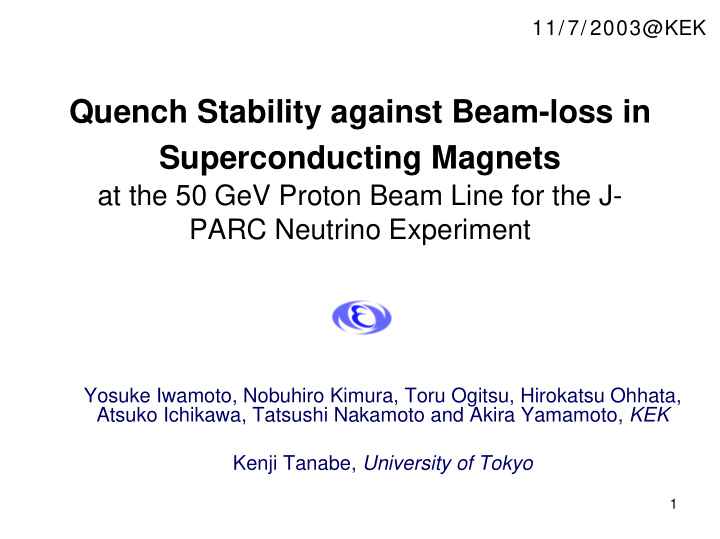



11/ 7/ 2003@KEK Quench Stability against Beam-loss in Superconducting Magnets at the 50 GeV Proton Beam Line for the J- PARC Neutrino Experiment Yosuke Iwamoto, Nobuhiro Kimura, Toru Ogitsu, Hirokatsu Ohhata, Atsuko Ichikawa, Tatsushi Nakamoto and Akira Yamamoto, KEK Kenji Tanabe, University of Tokyo 1
Contents Investigate the quench stability of the cables using J-PARC neutrino beam line In case of 50GeV-10W/point beam loss (Acceptable beam loss in view of shielding and maintenance) Calculate heat load for a 10 W/point beam loss in the cable by MARS code 2
Heat Load Simulation using MARS code Iron yoke collar Plastic spacer Corrector Y X 50GeV-10W beam Beam tube Coil 0 X Z 0 55 cm 330 cm Heat load will be up to 20 kJ/m 3 /pulse. Heating of 0-40 kJ/m 3 /pulse was used in experiment and the quench simulation. 3
Contents Investigate the quench stability of the cables using J-PARC neutrino beam line In case of 50GeV-10W/point beam loss (Acceptable beam loss in view of shielding and maintenance) Calculate heat load for a 10 W/point beam loss in the cable by MARS code is 20kJ/m 3 /pulse. Using Heating of 0-40 kJ/m3/pulse Measurements of temperature rise of the cable 4
Experiment 3.6 s 10 ms current Heat load (kJ/m 3 /pulse) 8, 14, 20, 28, 37 Current (A) 30, 40, 50, 60, 70 The cable used the same structure of superconducting magnet. It was made of CuNi in order to generate Joule heating. 5
Specimen overview Cross section of the cable 6
Experimental result 28 kJ/m 3 /pulse heat load. Temp. rise is proportional to heat load . 0.46 K temperature rise. 20 kJ/m 3 /pulse for a 50GeV-10W loss Instantaneous temp. rise = 0.25 K 7
Contents Investigate the quench stability of the cables using J-PARC neutrino beam line In case of 50GeV-10W/point beam loss (Acceptable beam loss in view of shielding and maintenance) Calculate heat load for a 10 W/point beam loss in the cable by MARS code is 20kJ/m 3 /pulse Using Heating of 0-40 kJ/m3/pulse Quench stability simulation. Measurements of temperature rise of the cable is 0.25 K for a 20kJ/m 3 /pulse loss . 8
Quench Stability Simulation Heat balance equation d dT dT = − − + = A k ( T ) Pq gA AC ( T ) q h ( T T ) s p s b dx dx dt h : heat transfer coefficient A : the overall cross section to SHe=2000 W/m 2 K K(T) : thermal conductivity of conductor T b : SHe bath temperature P : strand’s wetted perimeter a : strand diameter q s : heat transfer to SHe g : Joule heating in conductor C p (T) : volumetric specific heat of conductor 9
P/ π a ~ 0.4 (the actual cable) 20 kJ/m 3 /pulse heat load is OK (for a 50GeV-10W beam loss) 120 kJ/m 3 /pulse heat load (for a 50GeV-60W beam loss) may be acceptable. 10
Summary Calculation result by MARS which simulate the actual magnet in the J-PARC neutrino beam line Heat load in coil will be up to 20 kJ/m 3 /pulse for a 10W/point beam loss Experimental result Quench simulation result Not induce a quench. Instantaneous temp. rise At least, in the cable = 0.25 K 120 kJ/m 3 /pulse heat load for a 50GeV-60W beam loss may be acceptable. 11
Recommend
More recommend